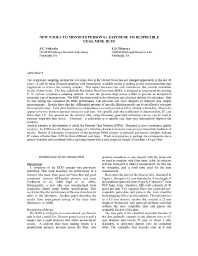Mining Publication: New Tools To Monitor Personal Exposure To Respirable Coal Mine Dust
Original creation date: January 2001
The compliance sampling method for coal mine dust in the United States has not changed appreciably in the last 30 years. A call for more frequent sampling with immediately available results is leading to new instruments that may supplement or replace the existing sampler. This report discusses two such instruments that provide immediate results of dust levels. The first, called the Respirable Dust Dosimeter (RDD), is designed to supplement the existing U. S. cyclone compliance sampling method. It uses the pressure drop across a filter to provide an inexpensive screening type of measurement. The RDD has been tested in the laboratory and a limited number of coal mines. Side by side testing has compared the RDD performance with personal coal mine samplers in triplicate area sample measurements. Results show that the differential pressure of specific filtration media can be an effective surrogate for respirable mass. Data show that there is a dependence on coal type and an effect of relative humidity. There also appear to be two distinct responses related to coal type. For specific coals the coefficients of determination, R2 , are better than 0.9. For general use the detector tube, using laboratory generated calibration curves, can be used to estimate respirable dust levels. However, a calibration to a specific coal type may substantially improve the accuracy. Another sampler in development is called the Personal Dust Monitor (PDM). Designed to give compliance quality accuracy, the PDM uses the frequency change of a vibrating element to measure dust and give immediate feedback of results. Results of laboratory comparison of the prototype PDM sampler to personal gravimetric samplers indicate R2 values of better than 0.99 for three different coal types. Work is in progress to package the components into a person-wearable unit combined with a cap lamp system with a total projected weight of less than 1.4 kg (3 lbs).
Authors: JC Volkwein, ED Thimons
Conference Paper - January 2001
NIOSHTIC2 Number: 20021471
In: Proceedings of the Seventh International Mine Ventilation Congress, 2001, Krakow, Poland, 2001 Jan; :143-150
See Also
- Dust Considerations When Using Belt Entry Air to Ventilate Work Areas
- The Effects of Water Spray Placement for Controlling Respirable Dust and Face Methane Concentrations
- Equivalency of a Personal Dust Monitor to the Current United States Coal Mine Respirable Dust Sampler
- Investigation of Coal Properties and Airborne Respirable Dust Generation
- Laboratory Evaluation of Pressure Differential-based Respirable Dust Detector Tube
- Laboratory Testing To Quantify Dust Entrainment During Shield Advance
- Performance of a Light Scattering Dust Monitor at Various Air Velocities: Results of Sampling in the Active Versus the Passive Mode
- Relationship of Coal Seam Parameters and Airborne Respirable Dust at Longwalls
- Using Proximate Analysis to Characterize Airborne Dust Generation from Bituminous Coals
- Using Ventilation Control Technology to Reduce Respirable Dust Exposures at U.S. Metal/Nonmetal Mining Operations
- Page last reviewed: 9/21/2012
- Page last updated: 9/21/2012
- Content source: National Institute for Occupational Safety and Health, Mining Program


 ShareCompartir
ShareCompartir
